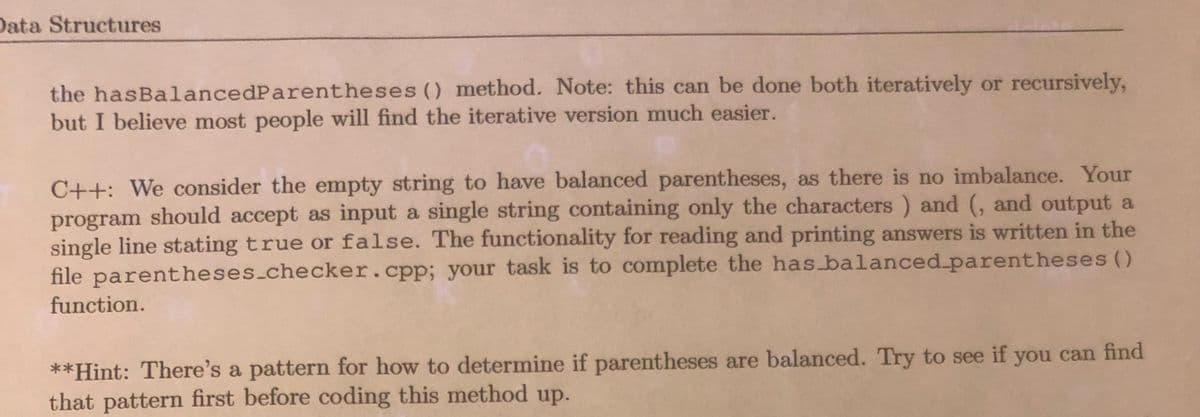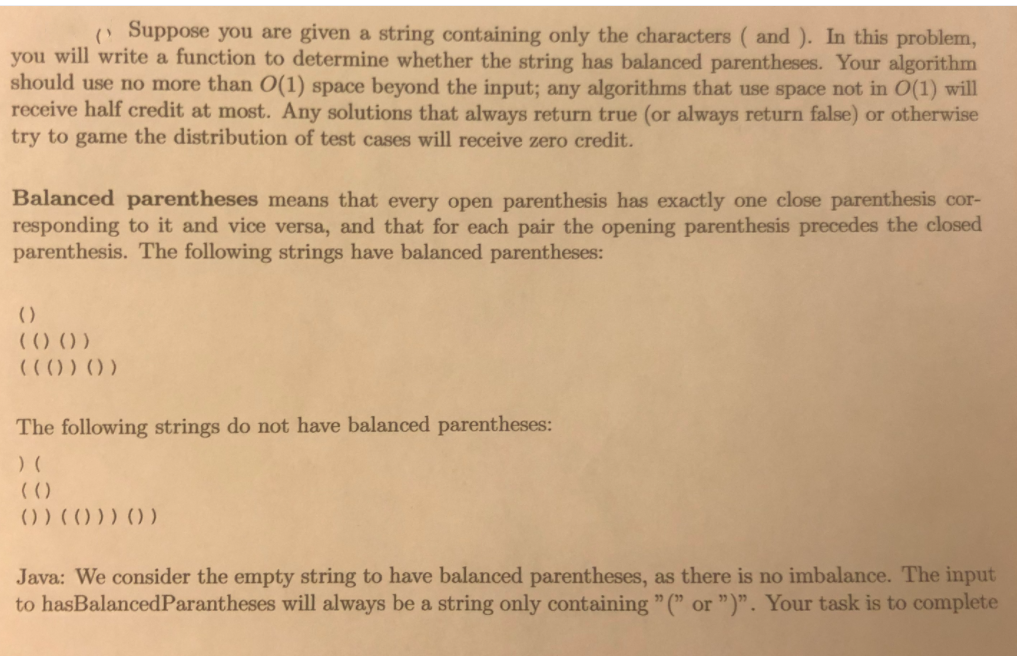Data Structures the hasBalancedParentheses () method. Note: this can be done both iteratively or recursively, but I believe most people will find the iterative version much easier. C++: We consider the empty string to have balanced parentheses, as there is no imbalance. Your program should accept as input a single string containing only the characters ) and (, and output a single line stating true or false. The functionality for reading and printing answers is written in the file parentheses.checker.cpp; your task is to complete the has balanced.parentheses () function. **Hint: There's a pattern for how to determine if parentheses are balanced. Try to see if you can find that pattern first before coding this method up. Suppose you are given a string containing only the characters ( and ). In this problem, you will write a function to determine whether the string has balanced parentheses. Your algorithm should use no more than O(1) space beyond the input; any algorithms that use space not in O(1) will receive half credit at most. Any solutions that always return true (or always return false) or otherwise try to game the distribution of test cases will receive zero credit. Balanced parentheses means that every open parenthesis has exactly one close parenthesis cor- responding to it and vice versa, and that for each pair the opening parenthesis precedes the closed parenthesis. The following strings have balanced parentheses: () (() () ) (C() ) ) ) The following strings do not have balanced parentheses: ) ( (() () ) ())) )) Java: We consider the empty string to have balanced parentheses, as there is no imbalance. The input to hasBalancedParantheses will always be a string only containing " (" or ")". Your task is to complete
Data Structures the hasBalancedParentheses () method. Note: this can be done both iteratively or recursively, but I believe most people will find the iterative version much easier. C++: We consider the empty string to have balanced parentheses, as there is no imbalance. Your program should accept as input a single string containing only the characters ) and (, and output a single line stating true or false. The functionality for reading and printing answers is written in the file parentheses.checker.cpp; your task is to complete the has balanced.parentheses () function. **Hint: There's a pattern for how to determine if parentheses are balanced. Try to see if you can find that pattern first before coding this method up. Suppose you are given a string containing only the characters ( and ). In this problem, you will write a function to determine whether the string has balanced parentheses. Your algorithm should use no more than O(1) space beyond the input; any algorithms that use space not in O(1) will receive half credit at most. Any solutions that always return true (or always return false) or otherwise try to game the distribution of test cases will receive zero credit. Balanced parentheses means that every open parenthesis has exactly one close parenthesis cor- responding to it and vice versa, and that for each pair the opening parenthesis precedes the closed parenthesis. The following strings have balanced parentheses: () (() () ) (C() ) ) ) The following strings do not have balanced parentheses: ) ( (() () ) ())) )) Java: We consider the empty string to have balanced parentheses, as there is no imbalance. The input to hasBalancedParantheses will always be a string only containing " (" or ")". Your task is to complete
C++ Programming: From Problem Analysis to Program Design
8th Edition
ISBN:9781337102087
Author:D. S. Malik
Publisher:D. S. Malik
Chapter15: Recursion
Section: Chapter Questions
Problem 6PE
Related questions
Question

Transcribed Image Text:Data Structures
the hasBalancedParentheses () method. Note: this can be done both iteratively or recursively,
but I believe most people will find the iterative version much easier.
C++: We consider the empty string to have balanced parentheses, as there is no imbalance. Your
program should accept as input a single string containing only the characters ) and (, and output a
single line stating true or false. The functionality for reading and printing answers is written in the
file parentheses.checker.cpp; your task is to complete the has balanced.parentheses ()
function.
**Hint: There's a pattern for how to determine if parentheses are balanced. Try to see if you can find
that pattern first before coding this method up.

Transcribed Image Text:Suppose you are given a string containing only the characters ( and ). In this problem,
you will write a function to determine whether the string has balanced parentheses. Your algorithm
should use no more than O(1) space beyond the input; any algorithms that use space not in O(1) will
receive half credit at most. Any solutions that always return true (or always return false) or otherwise
try to game the distribution of test cases will receive zero credit.
Balanced parentheses means that every open parenthesis has exactly one close parenthesis cor-
responding to it and vice versa, and that for each pair the opening parenthesis precedes the closed
parenthesis. The following strings have balanced parentheses:
()
(() () )
(C() ) ) )
The following strings do not have balanced parentheses:
) (
(()
() ) ())) ))
Java: We consider the empty string to have balanced parentheses, as there is no imbalance. The input
to hasBalancedParantheses will always be a string only containing " (" or ")". Your task is to complete
Expert Solution
This question has been solved!
Explore an expertly crafted, step-by-step solution for a thorough understanding of key concepts.
This is a popular solution!
Trending now
This is a popular solution!
Step by step
Solved in 2 steps

Recommended textbooks for you

C++ Programming: From Problem Analysis to Program…
Computer Science
ISBN:
9781337102087
Author:
D. S. Malik
Publisher:
Cengage Learning

C++ Programming: From Problem Analysis to Program…
Computer Science
ISBN:
9781337102087
Author:
D. S. Malik
Publisher:
Cengage Learning